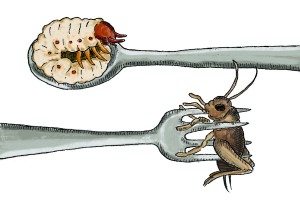Most of us regard them as creepy little pests that sting us and bite us, but it’s time to take a new look at insects. Put away your DEET and citronella candles and get ready to hold the first maggot roast in your neighborhood. Yes, folks — insects are the protein of the future.
First off, you should know that you have been eating insects for years and you just didn’t know it. If you open the Sanitation Defect Levels Guide, you will discover that allspice may contain 30 or more insect fragments per 10 grams, apple butter may contain five or more whole insects per 100 grams, and the same amount of tomato sauce may contain 20 or more fly eggs, along with two or more maggots. That confectioner’s glaze that coats your candy? It’s made from secretions out of the back end of the female lac bug. What you didn’t know hasn’t hurt you so far, so keep an open mind.
Scientists predict a steady population increase to 9 billion people as we reach the year 2050. Scarcities of land, water, forest and livestock resources could increase world hunger, and the Food and Agriculture Organization of the United Nations is now exploring insects as a new way to meet the nutrient needs of humans. In developing nations, insects have been a standard food source for hundreds of years, and if you’ve ever watched Andrew Zimmern’s show “Bizarre Foods” on the Travel Channel, you’ve seen him eat everything from deep fried tarantulas to raw maguey worms. It’s time the rest of the world caught up.
David Gracer, CCRI writing teacher and avid entomophagist, agrees. He has been eating bugs since 2001. “In terms of nutrition, efficiency and acceptability, insects are a kind of ‘final frontier.’ The planet is changing fast, and at some point in the foreseeable future, humanity will definitely need foods based on edible insects for survival.” Over the years he has made it his mission to introduce insects to chefs all over America. We need to learn more about this subject, and Gracer considers education to be a form of national service. The lessons could be tasty, too, since Thai giant water bug tastes like crab and citrus, while grasshoppers are a bit like jerky.
Gracer believes that “insects can feed the world. Cows and pigs are the SUVs; bugs are the bicycles.” The environmental advantages of insects are many. They can thrive on basically anything, even organic waste, and they emit far fewer greenhouse gases than livestock. They also consume far less water, and have a relatively tiny ecological footprint compared to the huge water and energy resources that go into simply growing the grain used for animal feed. 
So, how do insects stack up from an RDA point of view? A 3.5-ounce serving of raw grasshoppers contains between 14 and 28 grams of protein, a whopping amount for such a small amount of food. By comparison, a 3-ounce serving of ground beef contains about 15 grams of protein. Beetles are one of the richest insect sources of protein – a giant water beetle supplies about 20 grams of protein per 3.5 ounce, and a serving of palmworm beetle can have as much as 36 grams of protein. Like all insects, beetles supply calcium and iron, as well as a good dose of zinc. The exact amounts depend on the size and variety of insect you’re eating.
Nutritional value depends on a few other factors as well, and this is where there are a few kinks that need to be worked out before insects can be regarded as an optimal solution. The protein and nutrient content of crickets varies quite a bit depending on how they were raised and what they were fed. In one research experiment, crickets were fed different diets – one group ate corn, soy and grain-based feed, while other groups survived on food waste or crop residue. Nearly all the crickets fed nothing but waste and residue died before they could be harvested. The most successful crickets ate a grain-based diet similar to what most poultry is fed. Unfortunately, this made their protein conversion rate (food and water per edible protein produced) only slightly better than that for chicken.
Perhaps more research is necessary in order for insects to become the wonder food of the future, but the big question on your mind is probably: How does this stuff taste? I can say from personal experience that caterpillars can be quite delicious. While in Taiwan, I was served a spiced and deep fried variety that had the crispness of french fries with the flavor punch of Pad Thai.
Want to buy local? You can find insects for sale in many of the Asian markets in South Providence, but for a ready made tasty treat, head to Newport Jerky Company on Thames St for a bag of mixed bugs or chocolate-covered worms, among other creepy, crawly tasties, or settle in at Xaco Taco at 370 Richmond Street in downtown Providence. Along with non-GMO tortillas handmade daily, this restaurant features a taco option you won’t find at Chi Chi’s: chapulines. These crispy fried grasshoppers have been standard street fare in Mexico for hundreds of years. It seems this is one tradition that will survive long into the future.

